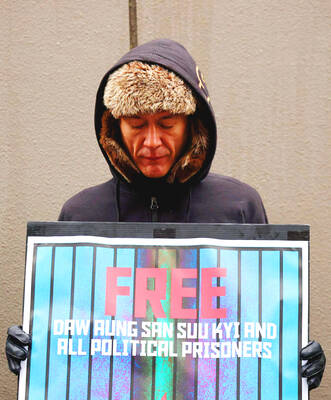Its tail is lopsided. Close up, it looks suspiciously like a small, and unremarkable, Asian elephant.
But scientists were on Tuesday hailing the sensational discovery of a perfectly preserved baby woolly mammoth, which died around 10,000 years ago, and was found in the frozen tundra of northern Russia.
Experts said the six-month-old female calf was a rare complete specimen. The animal's trunk and eyes are intact. It even has fur.
A reindeer herder, Yuri Khudi, stumbled across the carcass in May near the Yuribei river in Russia's Yamal-Nenents autonomous district, in a virtually inaccessible part of north-western Siberia.
Extinct woolly mammoths -- and giant tusks -- have turned up in Siberia for centuries. But it is unusual for a complete example to be recovered.
The last major find was in 1997 when a family in the neighboring Taymyr Peninsula came across a tusk attached to what turned out to be a 20,380-year-old mammoth carcass.
The latest 130cm tall, 50kg Siberian specimen appears to have died just as the species was heading for extinction during the last ice age.
It is being sent to Japan for further tests.
"The mammoth has no defects except that its tail was a bit off," Alexei Tikhonov, one of group of international experts who examined the mammoth last week in the Arctic town of Salekhard.
"In terms of its state of pre-servation, this is the world's most valuable discovery," he said.
Global warming has made it easier for woolly mammoth hunters to hack the animal out of Russia's thawing permafrost An entire mammoth industry has sprung up around the far eastern frontier town of Yakutsk.
Many examples are simply sold on the black market -- and can be seen in Russian souvenir shops, next to unhappy-looking stuffed brown bears.
Mammoths first appeared around 4.8 million years ago. Most of them died out 12,000 years ago at the end of the Pleistocene era.

The Burmese junta has said that detained former leader Aung San Suu Kyi is “in good health,” a day after her son said he has received little information about the 80-year-old’s condition and fears she could die without him knowing. In an interview in Tokyo earlier this week, Kim Aris said he had not heard from his mother in years and believes she is being held incommunicado in the capital, Naypyidaw. Aung San Suu Kyi, a Nobel Peace Prize laureate, was detained after a 2021 military coup that ousted her elected civilian government and sparked a civil war. She is serving a

China yesterday held a low-key memorial ceremony for the 1937 Nanjing Massacre, with Chinese President Xi Jinping (習近平) not attending, despite a diplomatic crisis between Beijing and Tokyo over Taiwan. Beijing has raged at Tokyo since Japanese Prime Minister Sanae Takaichi last month said that a hypothetical Chinese attack on Taiwan could trigger a military response from Japan. China and Japan have long sparred over their painful history. China consistently reminds its people of the 1937 Nanjing Massacre, in which it says Japanese troops killed 300,000 people in what was then its capital. A post-World War II Allied tribunal put the death toll

‘NO AMNESTY’: Tens of thousands of people joined the rally against a bill that would slash the former president’s prison term; President Lula has said he would veto the bill Tens of thousands of Brazilians on Sunday demonstrated against a bill that advanced in Congress this week that would reduce the time former president Jair Bolsonaro spends behind bars following his sentence of more than 27 years for attempting a coup. Protests took place in the capital, Brasilia, and in other major cities across the nation, including Sao Paulo, Florianopolis, Salvador and Recife. On Copacabana’s boardwalk in Rio de Janeiro, crowds composed of left-wing voters chanted “No amnesty” and “Out with Hugo Motta,” a reference to the speaker of the lower house, which approved the bill on Wednesday last week. It is

FALLEN: The nine soldiers who were killed while carrying out combat and engineering tasks in Russia were given the title of Hero of the Democratic People’s Republic of Korea North Korean leader Kim Jong-un attended a welcoming ceremony for an army engineering unit that had returned home after carrying out duties in Russia, North Korean state media KCNA reported on Saturday. In a speech carried by KCNA, Kim praised officers and soldiers of the 528th Regiment of Engineers of the Korean People’s Army (KPA) for “heroic” conduct and “mass heroism” in fulfilling orders issued by the ruling Workers’ Party of Korea during a 120-day overseas deployment. Video footage released by North Korea showed uniformed soldiers disembarking from an aircraft, Kim hugging a soldier seated in a wheelchair, and soldiers and officials